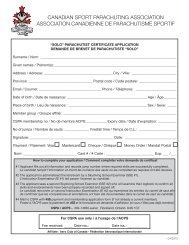PIM 1 2012 Final - Canadian Sport Parachuting Association
PIM 1 2012 Final - Canadian Sport Parachuting Association
PIM 1 2012 Final - Canadian Sport Parachuting Association
Create successful ePaper yourself
Turn your PDF publications into a flip-book with our unique Google optimized e-Paper software.
SECTION 1: ADMINISTRATIVE RECOMMENDATIONS AND INFORMATION<br />
1.1. DEFINITIONS:<br />
- ACC- Aero Club of Canada<br />
- ACPS- <strong>Association</strong> Canadienne du Parachutisme<br />
<strong>Sport</strong>if<br />
- BoD - Board of Directors<br />
- BSRs - Basic Safety Rules<br />
- CA - Certificate Administrator<br />
- CAC- Coaching <strong>Association</strong> of Canada<br />
- CNTC - Competition & National Teams Committee<br />
- CoP - Certificate of Proficiency<br />
- CSPA - <strong>Canadian</strong> <strong>Sport</strong> <strong>Parachuting</strong> <strong>Association</strong><br />
- CWC - Coaching Working Committee<br />
- DND - Department of National Defense<br />
- DZO - Drop Zone Operator<br />
- DZSA - Drop Zone Safety Advisor<br />
- EJR - Exhibition Jump Rating<br />
- FAI - Fédération Aéronautique Internationale<br />
- FJC - First Jump Course<br />
- IPC - International <strong>Parachuting</strong> Commission<br />
- LE - Logbook Examiner<br />
- NAC - National Airport Control<br />
- SC - <strong>Sport</strong> Canada<br />
- TC - Transport Canada Aviation<br />
- T&SC - Technical & Safety Committee<br />
1.2. <strong>Canadian</strong> resident sport parachutists are required to<br />
hold membership in CSPA for the extension of CSPA<br />
privileges. In the case of a dispute as to residential<br />
status, the BOD will be allowed the final decision.<br />
1.3. Whereas some member group activities may be run in<br />
an irresponsible manner, and whereas the Executive,<br />
Officers or individual group members may bring<br />
pressure on the member group for corrective measures,<br />
and the member group fails to do so, the CSPA BOD<br />
may suspend CSPA privileges for the member group<br />
where the member group has broken or allowed the<br />
breaking of CSPA BSRs or other membership rules.<br />
1.4. New members and visiting foreign Nationals who do not<br />
hold a CSPA/FAI CoP shall perform as many<br />
supervised jumps as deemed necessary by the DZ<br />
Operator, or a CSPA Instructor, before progressing to<br />
Solo Certificate status.<br />
1.5. CSPA privileges will only be extended to CSPA<br />
members and other FAI affiliated organizations<br />
members. Amongst other things, this will include:<br />
- Recognition of counter signatures in logbooks;<br />
- Recognition of jumps made where CSPA<br />
membership is held; and<br />
- Recognition of student training under CSPA auspices.<br />
1.6. No CSPA member, member group, or approved school<br />
will train for the purpose of making parachute descents,<br />
a person who will not be a member of CSPA at the time<br />
of his parachute descent.<br />
1.7. No person shall be allowed to jump under the auspices<br />
of CSPA member groups or drop zone, unless they<br />
produce:<br />
CSPA <strong>PIM</strong> 1 © April <strong>2012</strong> 4<br />
- Proof of current CSPA or FAI affiliate membership if<br />
non-resident<br />
- Logbook(s); record of jumps completed.<br />
- A CSPA Solo Certificate or CSPA Certificate of<br />
Proficiency. (Unless on student status—see 1.4)<br />
1.8. Following an occurrence, an Accident, Incident or<br />
Malfunction (AIM) report should be submitted to<br />
CSPA’s National Office by the DZSA. The CSPA<br />
member involved, CSPA Coach, Instructors, Riggers, or<br />
other qualified personnel may submit a report directly to<br />
CSPA, provided that the DZ Operator is informed of this<br />
action either verbally and/or by copy of the report.<br />
1.9. In the event of injury or 3rd party loss CSPA requires<br />
immediate notification and A.I.M. reports must be filed<br />
within ten (10) working days of the occurrence.<br />
1.10. For reasons of potential liability, persons under the<br />
legal age of majority should not be accepted for training<br />
or permitted to make a parachute descent.<br />
1.11. In the event a person over the age of 16, but under the<br />
age of legal majority is accepted for training, CSPA<br />
requires that written parental consent be obtained.<br />
Persons who have not reached 16 years of age shall<br />
not be accepted for training.<br />
1.12. Members are classified according to the level of CSPA<br />
CoP held. (See CoP Standards Sec. 6) All members<br />
who have not attained a CSPA Solo Certificate or<br />
higher, are classified as ‘Student’ parachutists.<br />
1.13. After jumps have been performed, logbook entries will<br />
be certified by a parachutist who actually witnessed the<br />
jump(s) and holds at least an CSPA A CoP or other FAI<br />
equivalent. Only logged and properly certified jumps are<br />
acceptable for issue of CSPA CoPs.<br />
Jumps used for CoP qualification purposes shall be<br />
endorsed by those rating holders indicated by the table<br />
in Section 6.<br />
1.14. Member groups and drop zones should maintain<br />
records of all students trained; these records will be<br />
made available for CSPA perusal if requested.<br />
1.15. Units of Measurement: in this manual, you will find<br />
measurements presented in units reflecting the aviation<br />
industry standard and conventions of aviation sport.<br />
1.16. Wording: The use of ‘shall’ and ‘must’ implies that the<br />
aspect concerned is mandatory; the use of ‘should’<br />
implies a non-mandatory recommendation; ‘may’<br />
indicates what is permitted and ‘will’ indicates what is<br />
going to happen. Words of masculine gender should be<br />
taken as including the feminine gender unless the<br />
context indicates otherwise.




